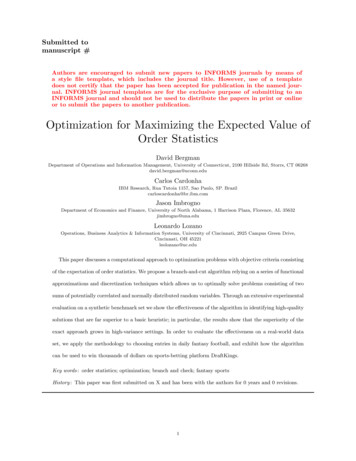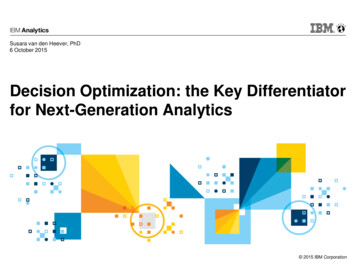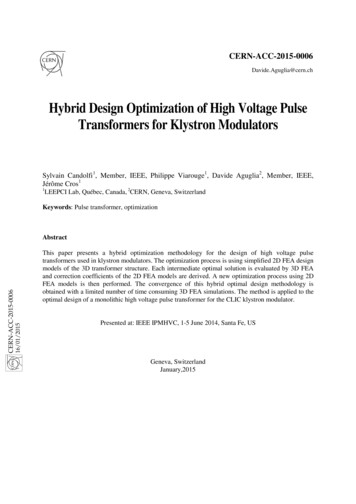
Transcription
Submitted tomanuscript #Authors are encouraged to submit new papers to INFORMS journals by means ofa style file template, which includes the journal title. However, use of a templatedoes not certify that the paper has been accepted for publication in the named journal. INFORMS journal templates are for the exclusive purpose of submitting to anINFORMS journal and should not be used to distribute the papers in print or onlineor to submit the papers to another publication.Optimization for Maximizing the Expected Value ofOrder StatisticsDavid BergmanDepartment of Operations and Information Management, University of Connecticut, 2100 Hillside Rd, Storrs, CT 06268david.bergman@uconn.eduCarlos CardonhaIBM Research, Rua Tutoia 1157, Sao Paulo, SP. Brazilcarloscardonha@br.ibm.comJason ImbrognoDepartment of Economics and Finance, University of North Alabama, 1 Harrison Plaza, Florence, AL 35632jimbrogno@una.eduLeonardo LozanoOperations, Business Analytics & Information Systems, University of Cincinnati, 2925 Campus Green Drive,Cincinnati, OH 45221leolozano@uc.eduThis paper discusses a computational approach to optimization problems with objective criteria consistingof the expectation of order statistics. We propose a branch-and-cut algorithm relying on a series of functionalapproximations and discretization techniques which allows us to optimally solve problems consisting of twosums of potentially correlated and normally distributed random variables. Through an extensive experimentalevaluation on a synthetic benchmark set we show the effectiveness of the algorithm in identifying high-qualitysolutions that are far superior to a basic heuristic; in particular, the results show that the superiority of theexact approach grows in high-variance settings. In order to evaluate the effectiveness on a real-world dataset, we apply the methodology to choosing entries in daily fantasy football, and exhibit how the algorithmcan be used to win thousands of dollars on sports-betting platform DraftKings.Key words : order statistics; optimization; branch and check; fantasy sportsHistory : This paper was first submitted on X and has been with the authors for 0 years and 0 revisions.1
(Anonymous): Maximizing the Expected Value of Order StatisticsArticle submitted to ; manuscript no. #21.IntroductionDecision making under uncertainty has been a major focus in the optimization literature (Dantzig1955, Charnes and Cooper 1959, Birge and Louveaux 1997, Sahinidis 2004). Coping with uncertainconstraints and/or objective function terms results in complex optimization problems that requireadvanced modeling and solution procedures such as robust optimization (Ben-Tal and Nemirovski1997, 2002, Bertsimas and Sim 2004, 2006) and scenario-based optimization (Higle and Sen 1991,Birge and Louveaux 1988, Shapiro and Homem-de Mello 1998, Carøe and Tind 1998, Kleywegtet al. 2002, Sherali and Zhu 2006, Gade et al. 2014), among others.In this paper we explore computational approaches to problems with objective criteria consistingof the expectations of order statistics. Given a set of m random variables X1 , . . . , Xm , the k th orderstatistic Y(k) is the k th lowest value assumed by these variables. We consider a class of stochasticbinary optimization problems where we seek to maximize the expectation of Y(k) given that eachof the random variables is a sum of random variables whose selection depends on the choice ofbinary variables, i.e., each component random variable Xi is defined by the selection in a vector ofdecisions variables denoted by x. To the best knowledge of the authors, such an objective functionhas not been studied in the optimization literature.Order statistics play a critical role in a variety of settings, and there is a rich literature dedicatedto their study. Some applications in which order statistics play a critical role include: Auctions: In auctions, the prices bidders pay are frequently determined by the first or secondhigher bidder (Brown and Brown 1986, Kaplan and Zamir 2012). Insurance: Insurance companies study order statistics (Ramachandran 1982, Dimitrova et al.2018), for example in determining policies for joint-life insurance. Systems: It is common practice to create systems that are robust to components failing, forexample in wireless communication networks (Yang and Alouini 2011). Risk Management: Risk management frequently requires the study of order statistics(Koutras and Koutras 2018)
(Anonymous): Maximizing the Expected Value of Order StatisticsArticle submitted to ; manuscript no. #3 Manufacturing: The lifetime of an item can be modeled through order statistics (Ahmadiet al. 2015)Due to the practical importance of order statistics and the need from practitioners to understandtheir underlying distributions, the statistics literature contains myriad papers dedicated to thesubject (the interested reader can refer to these books (David and Nagaraja 2004, Arnold et al.2008, Ahsanullah and Nevzorov 2005, Arnold and Balakrishnan 2012)). However, full distributional knowledge is limited to restrictive cases—in particular, this often requires the independentand identically distributed (iid) assumption. For example, if each component random variable isuniformly distributed and they are iid, then the order statistics follow beta distributions. Alternatively, if each component random variable is exponential and they are iid, then the minimumis also exponentially distributed, and the maximum follows the Gumbel distribution. In the presence of correlation between the random variables and/or differences in their distribution, limiteddistribution knowledge is known, in general. Due to the lack of exact distributional knowledge,some research has been published on bounds for the expected value order statistics for randomvariables that are correlated. Beyond this, little is known beyond bounds for general distributions(Bertsimas et al. 2006).Perhaps due to problem complexity, even under the iid assumption, no papers have publishedexact approaches to problems with objective functions modeled as the optimization of order statistics on the expectation of random variables. In such a problem, the random variables themselvesare functions of the decision variables, thereby resulting in a problem where the expectation ofthe order statistics is determined by the decision vector. Our paper proposes the first approach tosolving such a problem exactly.Due to the generality of such a problem, we focus on the case of two random variables, each ofwhich is the sum of normal random variables that are arbitrarily correlated, with the sum selectedthrough binary decision variables. In general, the exact distribution of order statistics for correlatedrandom variables is complex and unknown, with papers dedicated to exploring bounds even just for
(Anonymous): Maximizing the Expected Value of Order StatisticsArticle submitted to ; manuscript no. #4their expectations (Ross 2010, D’Eramo et al. 2016). For the normal distribution specifically andfor only two random variables, closed-form expressions for the expectation of both order statistics(the maximum and the minimum) are known (Nadarajah and Kotz (2008a)). The expression isnonlinear, in that it requires the evaluation of the p.d.f. and c.d.f. of a nonlinear function of theexpectations, variables, and correlation.When making decisions in order to optimize order statistics, we are therefore presented with ahard combinatorial optimization problem with a highly non-linear objective function, consisting ofthe square root of a quadratic function, that is the component of integral and rational equations. Inorder to solve the problem, we explore reformulations which allow us to compute tight relaxationsthat are enforced through cuts in a branch-and-cut framework.The algorithm is applied to two problem sets. The first is a large synthetic benchmark setdesigned to evaluate how the proposed algorithm scales and how the solutions obtained favoragainst a natural heuristic approach. Our thorough experimental evaluation on this benchmark setindicates that the algorithm scales well and that the solutions obtained are far superior to what theheuristic identifies, especially in scenarios where the variances of the random variables are large.Decision making under uncertainty is improved by learning parameters from real-world data.Therefore, we do not limit our approach to the domain of synthetic instances, but rather apply itto daily fantasy sports (DFS), where participants select entries of players in actual sporting eventssubject to roster and budget constraints. In order to choose optimal lineups in these DFS contests,one requires expected value estimates for each player in the game associated with a contest andestimates on the covariances of the player scores. There are myriad websites providing projectedpoints for players, but lacking are refined estimates for the correlations between player scores. Inthis paper, we suggest two different methods for estimating player-by-player covariance of scores,and use all of those parameter estimates to optimize picks in selected contests.We explore this application in Section 7, showing that our models can achieve selections in sportsbetting pools with skewed payout structures that could win thousands of dollars. The algorithm
(Anonymous): Maximizing the Expected Value of Order StatisticsArticle submitted to ; manuscript no. #5using our preferred correlation method would have resulted in 5,000 profit on less than a 10,000initial investment. The literature on applying advanced optimization to sports betting applicationshas been the topic of several papers (Brown and Minor 2014, Clair and Letscher 2007, Bergmanand Imbrogno 2017, Kaplan and Garstka 2001), and in particular some papers have arose thatstudy daily fantasy sports (Hunter et al. 2016, Urbaczewski and Elmore 2018), but to the best ofour knowledge, this is the first paper to study the showdown competition format available on thepopular DFS betting platform DraftKings; showdown contests only include the players in a singleNFL game, with entries consisting of 6 players.We note here that our problem applied to DFS is related to the static stochastic knapsackproblem, as items and their sizes are known a priori but their rewards are unknown. Literature onthe problem is typically focused on scenarios where both rewards and sizes are stochastic (Deanet al. (2008)). In our problem, rewards are actually correlated; Ma (2018) explored an LP relaxationof the problem to derive an approximation algorithm for the problem. Note that the stochasticknapsack problem with correlated rewards and sizes given in binary can be shown to be PSPACEhard (Dean et al. (2004)). To the best of our knowledge, settings of the stochastic knapsack problemwith several knapsacks with correlations between rewards of items assigned to different containershas not been addressed in the literature yet.In summary, our contributions are as follows: A first-ever exact algorithm for finding optimal decisions to problems with criteria specifiedby order statistics applied to expectations of random variables; An introduction of daily fantasy showdown contests to the literature; A nearest-neighbor algorithm for estimating covariance of points scored by different NFLplayers in DFS; and A thorough experimental evaluation which highlights the quality of solutions that can beobtained by our methodology in comparison with a basic heuristic, including a detailed report ofresults obtained on applying the methodology to real-world betting on the 2018 NFL season.
(Anonymous): Maximizing the Expected Value of Order StatisticsArticle submitted to ; manuscript no. #6The remainder of the paper is organized as follows. In Section 2 we formally define the class ofstochastic optimization problems we study. In Section 3 we describe complexity results. Section 4provides details of a novel basic branch-and-cut algorithm. Section 5 presents various additionaltechniques to improve the basic method, thus leading to a significantly improved algorithm. Sections 6 and 7 detail a thorough experimental evaluation, both on synthetic instances and DFSshowdown contests. Finally, we conclude in Section 8 with ideas for how this work can be expanded.2.Problem DescriptionIn this paper we study the problemmaxx Ω {0,1}n E Y(k) (x)(P)where Y(k) (x) is the kth order statistic among m random variables X1 (x),. . . ,Xm (x), each of whichis functionally dependent on decision variables x which are assumed to be binary and restricted toa set Ω. E(·) is the expected value, and so the objective is to maximize the expectation of the kthorder statistic. The kth order statistic is the kth smallest value in a statistical sample among acollection of random variables. And so, for a fixed k, the problem seeks to make choices of x so thatwe maximize the expectation of the kth smallest of the random variables X1 (x),. . . ,Xm (x) over allpossible samples. In particular, for k m, we seek to maximize the expectation of the largest ofthe variables.This class of optimization problems is challenging to solve in its full generality, and we studya specific case in this paper, where k m 2. Namely, suppose there are p items I {1, . . . , p},and each item i has a normally distributed profit Zi N (µi , σi2 ), with mean µi and variance σi2 .Two sets S 1 , S 2 I are to be selected for two bins. The selection of sets must satisfy a collectionof constraints R that can be specific for the individual bins, or based on joint conditions. Weassume that the constraints are uniform from bin to bin. The profit of a bin S is a random variabledefined as z(S ) : Pi SZi . We study the optimization problem of selecting items satisfying R and
(Anonymous): Maximizing the Expected Value of Order StatisticsArticle submitted to ; manuscript no. #7maximizing the 2nd order statistic, i.e., the expected value of the bin achieving the maximum totalprofit; namely, max {E max{z(S 1 ), z(S 2 )} : S 1 , S 2 satisfy constraints R}.S 1 ,S 2 IWe further assume that the random variables have arbitrary correlation between them. We use Σto denote the associated covariance matrix, where ρi,j is the correlation between Zi and Zj , so thatthe i, jth entry of Σ, the covariance of Zi and Zj , is cov(Zi , Zj ) ρi,j σi σj .With these assumptions, we can now formulate our problem as follows. For i 1, 2 and j 1, . . . , p, let xi,j be a binary variable indicating the selection of item j for bin i, and X(x) {X1 (x), X2 (x)} be a set of random variables determined byXi (x) pXZj xi,j , i {1, 2},j 1that is, each Xi (x) is a sum of random variables, where each binary variable xi,j indicates whether Zjis selected and should be considered in the sum for set i.Since each Zj is normally distributed, Xi (x) is normally distributed. Moreover, for any choiceof x {0, 1}2 p , one can calculate the mean and variance of X1 (x) and X2 (x), as well as theircovariance (and correlation). In particular:E [Xi (x)] pXµj xi,j i {1, 2}(1) i {1, 2}(2)j 1pσ 2 (Xi (x)) XXσj2 xi,j 2j 1cov (X1 (x), X2 (x)) cov(Zj1 , Zj2 )xi,j1 xi,j21 j1 j2 pppXXcov (Zj1 , Zj2 ) x1,j1 x2,j2 .(3)j1 1 j2 1We formulate our problem in the space of the x-variables as: max E Y(2) (x) max E [max {X1 (x), X2 (x)}] ,x Ωx Ω(4)where Ω is the subset of binary vectors which satisfy the constraints in R. We assume for theremainder of the paper that the constraints in R are linear in the x-variables.
(Anonymous): Maximizing the Expected Value of Order StatisticsArticle submitted to ; manuscript no. #8Nadarajah and Kotz (2008b) provide a closed form (non-analytical) expression for the maximumof two dependent normal random variables. Let φ(·) and Φ(·) be the probability density function(p.d.f.) and the cumulative distribution function (c.d.f.), respectively, of standard normal randomvariables; i.e., for w ( , ),1 w2φ(w) e 22πZ wΦ(w) φ(u)du. To handle edge cases in evaluating the c.d.f. at rational expression w 0, a 0 Φ (w) 1 , a 02 1, a 0.abwith b 0, we let We can now write a expression for E Y(2) (x) as: E [X1 (x)] E [X2 (x)]E Y(2) (x) E [X1 (x)] · Φ θ(x) E [X2 (x)] E [X1 (x)] E [X2 (x)] · Φθ(x) E [X1 (x)] E [X2 (x)]θ(x) · φ,θ(x)(5)whereθ(x) pσ 2 (X1 (x)) σ 2 (X2 (x)) 2cov (X1 (x), X2 (x)).(6)As we can see from Equality 5, due to the (possible) dependency among the random variablesX1 (x) and X2 (x), the expectation of their maximum is a highly nonlinear function.The main methodological contribution of the paper is an exact mathematical programmingalgorithm for tackling this highly complex optimization problem. A motivating example is dailyfantasy football, as described in the introduction, where the sets correspond to the entries that aparticipant can choose from, and the index set [p] of Zj variables are the players available for each
(Anonymous): Maximizing the Expected Value of Order StatisticsArticle submitted to ; manuscript no. #9entry. Linear constraints enforce that a viable entry is selected (e.g., based on number of playersin each position and budget constraints).In order to understand the general applicability of the algorithms developed and how theyscale with problem size and varied problem characteristics, we investigate the application of thealgorithms to synthetic scenarios of the problem where knapsack constraints limit the number ofitems selected for each bin. We experimentally evaluate cases when the items selected are allowedto be selected for both bins or for only one; i.e, with and without the constraintsx1,j x2,j 1,j 1, . . . , p.(7)We note that even though our approach is tailored to the case in which k m 2, the proposedalgorithms and results can be easily extended to the case in which k 1, i.e., the objective seeksto maximize the minimum between X1 (x) and X2 (x).3.Computational complexityThe following result shows that the variant of problem P we study is NP-hard.Theorem 1. P with k m 2 is NP hard.Proof.The result follows from a reduction from the minimum cut problem on a graph withpositive and negative weights; the problem is known to be NP-hard in the general case (McCormicket al. (2003)). Let G (V, E) be an undirected graph with integer weights we of arbitrary sign oneach edge e E. A (S, T )-cut of G is a 2-partition of V , and its weight w(S, T ) is the sum of theedges crossing the cut, i.e., w(S, T ) Pwe . The minimum weight cut is a cut of minimume:e S,e T 6 weight. As a decision problem, the problem can be posed as follows: given a constant K, does thereexist a (S, T )-cut of G such that w(S, T ) K.We create an instance of P as follows. Assuming there are p vertices in G, every vertex j Vis associated with an item j with a normally distributed profit Zj N (0, 1), for j 1, . . . , p. Thecovariance between Zj1 and Zj2 is cov(Zj1 , Zj2 ) we have thatPpj1 1Ppj2 1j2 6 j1cov(Zj1 , Zj2 ) 2M4M 1 12w{j ,j }1 2,4M 1where M and σj21 Pj2 6 j1Pe E we . As a result, cov(Zj1 , Zj2 ) for all j1
(Anonymous): Maximizing the Expected Value of Order StatisticsArticle submitted to ; manuscript no. #101, . . . , p. One can then construct a symmetric and diagonally dominant (and, consequently, positivesemi-definite) matrix Σ whose columns and rows are indexed by variables Zj . It follows that Σ is avalid covariance matrix. Finally, let Ω {0, 1}2 p , i.e., the set of feasible solutions is unconstrained.By construction, E[X1 (x)] E[X2 (x)] 0, so the expression for E[Y(2) (x)] reduces to:1E[Y(2) (x)] θ(x) .2πAs p 1 and all variances are equal to 1, it follows that at optimality θ(x) 1 (this value is achievedif we assign one item to the first set and leave the second set empty), so any x that maximizesθ(x)2 also maximizes θ(x). Therefore, the optimization of E[Y(2) (x)] in our case is equivalent to max θ2 (x) σ 2 (X1 (x)) σ 2 (X2 (x)) 2cov(X1 (x) X2 (x)) .x ΩBy expanding the terms of the last expression, we obtain2θ(x) pX2σ (Zj )x1,j 2j 1 p 1pXXpX2σ (Zj )x2,j 2j 1p 2cov(Zj1 , Zj2 )x1,j1 x1,j2j1 1 j2 j1 1p 1pXXcov(Zj1 , Zj2 )x2,j1 x2,j2j1 1 j2 j1 1pXXcov(Zj1 , Zj2 )x1,j1 x2,j2 .j1 1 j2 1Because all variances are equal to 1, we have2θ(x) pXx1,j 2j 1 cov(Zj1 , Zj2 )x1,j1 x1,j2j1 1 j2 j1 1pXx2,j 2j 1p 2p 1pXXXj 1p 1pXXcov(Zj1 , Zj2 )x2,j1 x2,j2j1 1 j2 j1 1ppx1,j x2,j 2X Xcov(Zj1 , Zj2 )x1,j1 x2,j2 ,j1 1 j2 1j2 6 j1Claim 1 In any optimal solution for maxx Ω θ(x)2 , x1,j x2,j 1 for j 1, . . . , p.(8)
(Anonymous): Maximizing the Expected Value of Order StatisticsArticle submitted to ; manuscript no. #11Proof First, by reorganizing the terms in 8, we obtainθ(x)2 pXx1,j pXj 1 2x2,j 2j 1pXx1,j x2,jj 1( p 1pX Xcov(Zj1 , Zj2 )x1,j1 x1,j2 j1 1 j2 j1 1p p 1pXXpX Xcov(Zj1 , Zj2 )x2,j1 x2,j2j1 1 j2 j1 1cov(Zj1 , Zj2 )x1,j1 x2,j2 . j1 1 j2 1j2 6 j1Let A(x) denote the sum within the brackets ({}); A(x) belongs to the interval defined by ppXXcov(Zj1 , Zj2 ),j1 1 j2 1j2 6 j1because each covariance term appears at most twice with a positive coefficient and at most twicewith a negative coefficient. By construction,PpPpj1 1j2 1j2 6 j1cov(Zj1 , Zj2 ) 12 , so we have that 1 2A(x) 1. Therefore, any optimal solution to maxx Ω θ(x)2 also optimizesmax( pXx Ωx1,j j 1pXx2,j 2j 1pX)x1,j x2,j,j 1since the absolute value of each of the coefficients in this expression is greater than or equal to 1.Finally, note that this expression is maximized if and only if x1,j x2,j 1, as desired.It follows from Claim 1 thatPpj 1 (x1,jmax f (x) θ(x)2 p 2 x2,j 2x1,j x2,j ) p, a constant, so we have( p 1pX Xx Ω cov(Zj1 , Zj2 )x1,j1 x1,j2j1 1 j2 j1 1 p 1pXXcov(Zj1 , Zj2 )x2,j1 x2,j2j1 1 j2 j1 1p pX Xj1 1 j2 1j2 6 j1s.t.cov(Zj1 , Zj2 )x1,j1 x2,j2 (9) x1,j x2,j 1j 1, . . . , pxi,j {0, 1}i 1, 2, j 1, . . . , p.
(Anonymous): Maximizing the Expected Value of Order StatisticsArticle submitted to ; manuscript no. #12Consider the following optimization problem:min h(x) ppXXcov(Zj1 , Zj2 )x1,j1 x2,j2j1 1 j2 1j2 6 j1(10)s.t.x1,j x2,j 1j 1, . . . , pxi,j {0, 1}i 1, 2, j 1, . . . , p.Claim 2 An optimal solution to optimization problem (10) is also optimal to problem (9).Proof Both optimization problems have the same set of feasible solutions Ω0 . Let x0 and x00 be twofeasible solutions with h(x0 ) h(x00 ). Showing that f (x0 ) f (x00 ) establishes the claim. To showthis, we first note that for any feasible solution x̃,p 1pXXcov(Zj1 , Zj2 )x̃1,j1 x̃1,j2 j1 1 j2 j1 1 ppXXp 1pXXcov(Zj1 , Zj2 )x̃2,j1 x̃2,j2j1 1 j2 j1 1cov(Zj1 , Zj2 )x̃1,j1 x̃2,j2 j1 1 j2 6 j1p 1pXX(11)cov(Zj1 , Zj2 ).j1 1 j2 j1 1This follows because for any two indices j1 6 j2 , the covariance term cov(Zj1 , Zj2 ) is counted inexactly one of the three terms in the left-hand size of equation (11):1. If x̃1,j1 x̃1,j2 1 cov(Zj1 , Zj2 ) is counted only in the first term;2. If x̃2,j1 x̃2,j2 1 cov(Zj1 , Zj2 ) is counted only in the second term;3. If x̃1,j1 1, x̃2,j2 1 cov(Zj1 , Zj2 ) is counted only in the third term; and4. If x̃2,j1 1, x̃1,j2 1 cov(Zj1 , Zj2 ) is counted only in the third term.Finally, because x̃1,j1 x̃2,j1 1 and x̃1,j2 x̃2,j2 1, it follows that the list above is exhaustive andcontains all possible assignments of j1 and j2 . Therefore,h(x0 ) h(x00 ) 2h(x0 ) 2h(x00 ) p 1XpXj1 1 j2 j 1 1cov(Zj1 , Zj2 ) 2h(x0 ) p 1Xj1 1 j2 j 1 1f (x0 ) f (x00 ),as desired. pXcov(Zj1 , Zj2 ) 2h(x00 )
(Anonymous): Maximizing the Expected Value of Order StatisticsArticle submitted to ; manuscript no. #13We conclude that an optimal solution to (10) is also optimal to the original problemmax{E[Y(2) (x)]}.x ΩThere is a one-to-one mapping between solutions to (10) and (S, T )-cuts of G. Namely, for afeasible solution x0 we associate it with the (S(x0 ), T (x0 ))-cut defined by x01,j 1 j S(x0 ) andx02,j 1 j T (x0 ). Additionally, w(S(x0 ), T (x0 )) K if and only if h(x0 ) K.4M 1This followsbecausew(S(x0 ), T (x0 )) XXw{j1 ,j2 }j1 S(x0 ) j2 T (x;) XX(4M 1) cov (Zj1 , Zj2 )j1 S(x0 ) j2 T (x0 ) (4M 1)pXpXcov (Zj1 , Zj2 )j1 1 j 2 1,j2 6 j1 (4M 1) h(x0 ).Therefore, if one can solve (10), one can also solve the family of instances of (P) presented in ourconstruction, thus giving an algorithm that decides exactly the minimum cut problem with positiveand negative edge weights.4. A Cutting-Plane AlgorithmExpression (5) is highly nonlinear, thus making the application of direct formulations combinedwith off-the-shelf solvers unlikely to be satisfactory for (P) and its extensions. In this work, wepresent an exact cutting-plane algorithm to solve problem (P) when k m 2. The main component of our approach is a mixed-integer linear program (MIP), which we refer to as the relaxedmaster problem (RMP), that provides upper bounds on the optimal objective value and is iteratively updated through the inclusion of cuts. Lower bounds are obtained through the evaluation of E Y(2) (x) on the feasible solutions obtained from the optimization of the RMP. Section 4.1describes our proposed cutting-plane algorithm, and Section 4.2 presents a basic formulation ofthe RMP, based on a standard McCormick linearization technique.
(Anonymous): Maximizing the Expected Value of Order StatisticsArticle submitted to ; manuscript no. #144.1.Algorithm DescriptionOur approach to solve the problem is presented in Algorithm 1. A key component of our algorithm is the construction of a linear upper-bounding function for E Y(2) (x) defined over the set Ω offeasible solutions. Namely, we wish to work with a function g(x) such that g(x) E Y(2) (x) x Ω.Given g(x), the relaxed master problem can be stated asz̄ max g(x),x Ω(RMP)where Ω(C ) represents the restriction of Ω to solutions that also satisfy a set of constraints C . Notethat z̄ provides an upper bound on the optimal objective value of problem (P).Algorithm 1 solves problem RMP iteratively, adding no-good constraints (or simply cuts) toa set C , which are incorporated to RMP in order to prune solutions previously explored (Balasand Jeroslow 1972). RMP(C ) denotes RMP enriched by the inclusion of (all) cuts in C , so that asolution x for RMP(C ) belongs to Ω and satisfies all constraints in C .Our cutting-plane algorithm keeps a lower bound LB and an upper bound UB for expression (5),which are non-decreasing and non-increasing over time, respectively. Both values are computed(and iteratively updated) based on each incumbent solution x̂ of RMP; upper bounds are given by g(x̂) and lower bounds follow from the exact evaluation of E Y(2) (x̂) . Algorithm 1 terminatesif LB becomes equal to UB or if RMP(C ) becomes infeasible. Because Ω is finite set, each cutincorporated to C removes at least one solution from Ω, and C increases in each iteration, it followsthat Algorithm 1 terminates with an optimal solution in a finite number of iterations.
(Anonymous): Maximizing the Expected Value of Order StatisticsArticle submitted to ; manuscript no. #15Algorithm 1 A Cutting-Plane Algorithm1: Set LB , UB , C , and incumbent solution x̄ 02:Solve RMP(C ). If the problem is infeasible, then go to Step 5. Otherwise, let UB be the optimalobjective function value obtained for this problem, and record the optimal solution x̂ found. 3: Compute E Y(2) (x̂) using Equation (5). If E Y(2) (x̂) LB, set LB E Y(2) (x̂) and updateincumbent x̄ x̂.4:If LB UB, go to Step 5. Otherwise, add a no-good constraint to C which is violated solelyby x̂ among all solutions in Ω. Return to Step 2.5:If LB , then terminate and conclude that the original problem is infeasible. Otherwise,terminate with an optimal solution given by x̄.4.2.A Standard Approach to Obtain Upper BoundsA challenging task involved on the optimization of (P) is the evaluation of θ(x), a nonlinearexpression that appears in all terms of expression (5), including the denominators of the c.d.f.and the p.d.f. of the normal distribution. In the following proposition, we show how to derive anupper-bounding function for (5) which avoids technical issues involved in the evaluation of θ(x).In order to simplify notation, we assume w.l.o.g. throughout the manuscript that E [X1 (x)] E [X2 (x)]; we also use δ(x) E [X1 (x)] E [X2 (x)] to simplify a recurring expression in the text.Proposition 1. For every x Ω, 11 θ(x)2 .E Y(2) (x) E [X1 (x)] 2π(12)Proof From the symmetry around 0 of the c.d.f. of the standard normal distribution, we haveΦ(a) Φ( a) P [X a] P [X a] P [X a] 1 P [X a] 1for any a R. Therefore, it follows that δ(x)Φθ(x) δ(x) Φθ(x) 1.
(Anonymous): Maximizing the Expected Value of Order StatisticsArticle submitted to ; manuscript no. #16As Φ is a c.d.f. and, therefore, non-negative, and as E [X1 (x)] E [X2 (x)] by assumption, we have E [X1 (x)] Φ δ(x) δ(x)E [X1 (x)] ΦE [X2 (x)] ,θ(x)θ(x)(13)because the multipliers form a convex combination, so we have an upper bounding expression for the first two terms of E Y(2) (x̂) . δ(x)δ(x)1, first note that φ θ(x) φ(0) 2π, becauseIn order to find an upper bound for θ(x) · φ θ(x)the p.d.f. of the standard normal random variable is maximized at its mean 0. Additionally,because θ(x) 0, θ(x) 1 θ(x)2 for every x, so we have δ(x)1 .1 θ(x)2 θ(x) · φθ(x)2π(14)Finally, Inequality (12) follows from the addition of Inequality (13) with Inequality (14): δ(x) δ(x)δ(x)E Y(2) (x) E[X1 (x)] · Φ E[X2 (x)] · Φ θ(x) · φθ(x)θ(x)θ(x) 1 E[X1 (x)] 1 θ(x)2 . 2πBy using the right-hand side expression of Inequality (12) as the objective function of RMP, oneneeds to evaluate θ(x)2 rather than θ(x), thus avoiding the square root operator. θ(x)2 is given byθ(x)2 σ 2 (X1 (x)) σ 2 (X2 (x)) 2cov (X1 (x), X2 (x)) .(15)A direct formulat
binary optimization problems where we seek to maximize the expectation of Y (k) given that each of the random variables is a sum of random variables whose selection depends on the choice of binary variables, i.e., each component random variable X iis de ned by the s










